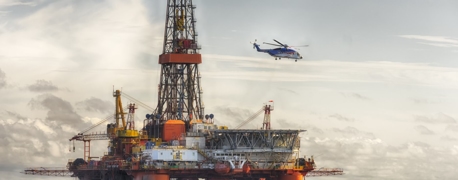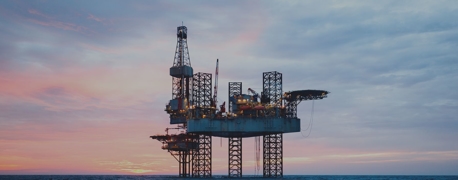Oil Rig Workers Are Well Paid, But Are the Dangers Worth the Money?

It is no secret that oil rig workers stand to make an impressive paycheck, even in entry-level positions. However, are these salaries worth the dangers that they face on a daily basis?
Salaries for an entry-level oil rig position, such as a maintenance roustabout, average around $47,000 per year, with management positions making well over $100,000 per year. This high-level pay combined with a schedule that includes 3/5 of the year off per average employee sounds like a sweet deal for offshore workers.
Part of the reason that offshore oil rig worker pay is high is to offset the difficult working conditions and risks associated with the job. Workers often face 14/21 shifts, meaning that they work for 14 days straight, followed by 21 days off. Each day on the rig comes with hard manual labor for many workers, sometimes including night shifts on the 24-hour operation. Two straight weeks at sea can be a harrowing experience for many, although some rigs are equipped with impressive living quarters for the crew.
Also, oil rig crews face some of the highest rates of injuries and fatalities in the country. In 2008 alone, 120 workers in the oil and gas industry were killed on the job. The amount of workers killed in this field from 2003 to 2010 is seven times higher than that of all other industries in the U.S., according to the Occupational Safety & Health Administration (OSHA). According to a recent report from the Center for Public Integrity, 1,566 workers died in the oil and gas industry between 2008 and 2017—more deaths than many industries combined during the same period. This means that it’s crucial that workers are aware of the dangers present on an oil rig.
Dangers Present on an Oil Rig
FIRES
While this hazard seems obvious, it’s important to mention since it’s one of the leading causes of death on an oil rig. Petroleum is highly combustible and when it is mixed with other hazardous chemicals like hydrogen sulfide, it becomes even more dangerous. The U.S. Centers for Disease Control estimates that 7 percent of all oil rig fatalities are caused by blazes. Oil rig fires are devastating because they usually start with an explosion and end with a chemically fed fire that is difficult to put out. In many cases, crews must wait for oil rig fires to burn themselves out.
FATIGUE
Ask any roughneck about their job, and they’ll immediately tell you how difficult it is. Oil mining is rigorous and requires physical labor and long hours. An average oil rig worker can work shifts exceeding 8 hours for 7 to 14 days in a row. As they deal with the heavy machinery and equipment used on a rig, crews can experience the dangers of fatigue.
Many are surprised to know that fatigue isn’t just dangerous on the oil rig for workers, it kills many of them when they aren’t on one. One study found that oil industry workers are 8.5 times more likely to die in a motor vehicle accident than those in other industries. Since it isn’t uncommon for oil rig workers to work shifts of 12 hours or more, their drive home can be deadly. Small roads connecting oil sites to residential areas can be dangerous because of fatigued workers driving home.
MACHINERY
Oil mining requires the use of heavy machinery, including drills, cranes, forklifts, pipes, and more. Having proper machinery and using it right means employees can do their job safely and that materials will be handled correctly. If equipment is not properly maintained, it can malfunction. Even a small amount of maintenance neglect by a company can cause a catastrophic failure of machinery that claims lives. As mentioned above, employees need to be completely cognizant when operating such machines. Given the long hours and tiring nature of the job, too many workers fall victim to negligent machine operation.
FALLS
The Centers for Disease Control estimates about 7 percent of oil field workers die from falls. With hazardous materials on the floor and falling tools, workers can easily encounter danger from an unexpected object. It is the responsibility of the employers to maintain safe environments and uphold strict protocol.
Other Dangers Faced by Oil Rig Workers
In addition to the hazards listed above, oil rig workers may face such dangers as:
- Being struck by debris
- Drowning
- Exposure to toxic chemicals
- Burns
- Helicopter crashes
- Electrocution
- Head and brain injury
- Back injury
- Muscle strain from heavy lifting and repetitive motions
Being at sea also means that the rig is cut off from certain types of medical care. While each rig staffs a doctor or medic, there is always a chance that a situation will occur in which the rig is not equipped with the needed equipment. In that case, the delay in treatment can exacerbate an offshore injury or even lead to wrongful death. If you have been injured while working on an oil rig, you should consult with an experienced lawyer to learn about your legal rights. Our oil rig injury attorneys represent rig workers throughout the nation.
Call Arnold & Itkin for Help After an Oil Rig Accident
The oil rig accident lawyers from Arnold & Itkin understand the dangers that oil workers face. Too frequently, our team has seen employees injured because of inadequate equipment, training, or other safety issues on their oil rig. We know that employers should be held accountable for neglecting to provide a safe work environment for workers. We're always ready to help injured workers receive the help they deserve.
Consultation with a member of our team is free of charge when you dial (888) 493-1629. Importantly, you pay nothing unless we win your case.
- Categories


